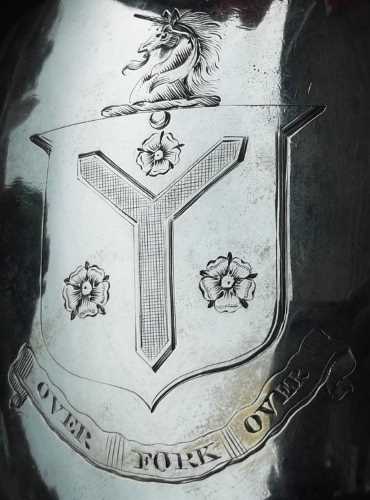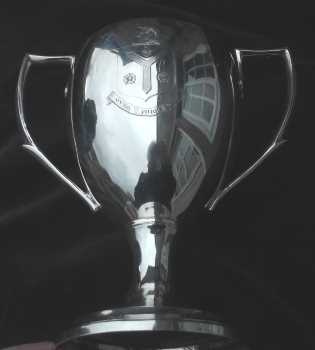by Dr. David N. Nikogosyan:
B.BOHRMANN / B.BOHRMANN NACHFOLGER (SUCCESSOR) COMPANY,
FRANKFURT/MAIN, GERMANY. 1. HISTORY

B.BOHRMANN / B.BOHRMANN NACHFOLGER (SUCCESSOR) COMPANY
FRANKFURT/MAIN, GERMANY. 2. LIST OF MARKS

The author writes "I would like to present the famous graphic mark of B.Bohrmann's foundry, used both on cutlery and hollow ware from the 1860's until c.1887. By the way, it is the only Bohrmann's mark, mentioned by Reinhard Sänger in his book on German cutlery without any explanation/specification. This mark consists of a candle, set in an oval inside a hatched square and two "B" letters around the candle, taken from the initials of B.Bohrmann. The fascinating peculiarity of this mark is the fact that the left "B" letter is a mirror reflection of the right one and vice versa. In my opinion, this mirror reflection accounts for the wide use of punching at early stages of Bohrmann's hollow ware silver plate production. This very original "BB" mark was used from 1860's until c.1887."
click here for 1. HISTORY 2. LIST OF MARKS

A STERLING RENAISSANCE
British Silver Design 1957 to 2018
An exhibition until May 12, 2019 at San Francisco International Airport
International Terminal - Departures - Level 3 - Pre-Security

During the postwar years, anyone looking to produce modern design looked to Scandinavia for inspiration, and British silversmiths were no exception. In the late 1950s, an American named Mrs. Lasky travelled to London to visit a friend. Wanting to see modern British silver, she visited the studio of Gerald Benney (1930-2008). Upon viewing his stock items, Mrs. Lasky proclaimed they were not British, but Scandinavian. Shaken by the charge that he was following the Bauhaus School, Benney set out with four or five others to create a distinctively English silver that was "rugged, solid, and functional, but at the same time modern."
Benney was a true designer-silversmith, controlling the creative process to produce singular works. While Benney's commissioned pieces during the 1950s were already departing from prevailing design trends, his most distinguishing innovation occurred by chance in 1961. While hand-raising the bowl of a cup, he inadvertently used a damaged planishing hammer that instead of smoothing, textured the silver's surface. Liking the effect, Benney filed the hammer's head to emphasize the pattern and proceeded to texture a series of objects. Benney's "Bark Finish" provided a modern look to his forms and made his work instantly recognizable.
Benney and the Australian-born Stuart Devlin (1931-2018) studied silversmithing in London during the early and late 1950s respectively. In the early 1960s, Devlin trained as a sculptor in the United States. Seeing that British silversmiths had abandoned the Scandinavian influence, Devlin decided to return to England to become a smith making rich and romantic objects. From his experience as a sculptor, he introduced textures using molten metal and made filigree forms of almost any kind. These had never been seen on silver items before. Benney and Devlin made a profound and lasting impact on the direction of silver. This influenced succeeding generations of smiths who expanded the definition of British silver through their unique applications of traditional processes and further innovative techniques.
Today, Britain continues to provide the expertise and creative environment that nurtures home-grown talent and attracts student silversmiths from around the world who bring a diversity of influences to British silver design. The Worshipful Company of Goldsmiths, more commonly known as the Goldsmiths' Company, plays a significant role in this ongoing development through patronage, educational programs, and training offered at its Goldsmiths' Centre in London. So too does Edinburgh's Incorporation of Goldsmiths, which promotes education within the trade and encourages patronage through its annual festival and purchasing exhibition. With today's silversmiths influenced by the work of the twentieth-century modernists and, in turn, informing the direction of British silver into the twenty-first century, Great Britain's role as the leader in contemporary silver design is assured. The best is yet to come.

Buxeda is a jeweller of Barcelona, Spain. 916/00 is the current silver fineness in Spain.
The actual Spanish hallmarking system is organized on a voluntary base.
In my opinion the bowl is a modern item made in Spain.
Giorgio Busetto
Robin Gibson writes:
... I am unable to identify the maker of these wick trimmers.
Markings are..
Crown
Warranted
W C W C
If you could identify I would be most grateful
Best wishes
Robin Gibson
The maker is W. Carter, Old Sheffield Plate Maker, New Church Street, Sheffield, active 1839. The plating, largely rubbed, was made using the close plating technique
Giorgio Busetto
Katherine Palthey writes:
... my question is: WHERE and when these spoons are from?
After a long search, I see possible traces to Austro Hungarian marks from 1845 (Poland section of Tardy page 328)
or maybe as early as German Nurenberg? 18th century???
The 12 and NG may correspond at one time?
There are 6 spoons and with fine engraving: seems more like early 19th century to me.
Any ideas?
I have searched internet everywhere for similar hallmarks, but no luck.
Katherine Palthey
The problem is that your spoons are missing of any town mark. They have only silver fineness and maker's mark.
Their provenance is, correctly, "German area" (Germany, Austria) probably early 19th century but I have no other idea about their exact origin.
Anyway, I'll publish your question in March newsletter. Maybe someone having a deeper knowledge of the matter will be more helpful in your research.
Giorgio Busetto
Ole Lachmann writes:
... I just bought a very interesting Bauhaus type of silver egg cup, with a mark I cannot identify.
Can anyone help ?
I am enclosing a photo of the maker's mark alone and one of maker's mark + STAMER which probably is the sellers shop name.
There are also an 800 mark and the German crown and moon
Best wishes
Ole Lachmann
Peter Markham writes:
... I have recently bought a set of pistol grip dinner knives marked only on the handle, on one side the lion passant and the other the hallmark RM over BS.
My research has not revealed any such combination for London, Sheffield or Birmingham. I enclose a couple of images.
Could you shed some light on this matter?
Best regards
Peter Markham
The makers are Richard Morson & Benjamin Stephenson, mark entered in London Assay Office on 27.10.1762
Giorgio Busetto
Scott Davidson writes:
... I found some info on your site and would like your help if possible in getting closer to its date.
I have enclosed a few pictures.
Thanks
Scott Davidson
The maker is Sheffield Nickel & Silver Plating Co, Globe Works, Sheffield.
The date is c. 1873-1886, but you can date exactly your item using the date letter on the collar (not visible in your photo).
By the way, only the collar is sterling silver, blade and fork are silverplate.
Giorgio Busetto
In this column we presents a page obtained from makers'
brochures, books, auction catalogs, advertising or whatever
other printed paper, related to silver, that may be of interest
for ASCAS members.
The images will be published at a "low resolution" level and for
private and personal use only.
This column is published under the kind permission of Giorgio
Busetto's website
SILVER ADVERTISEMENTS
FACTORIES, PLANTS, SALESROOMS, SHOPS AND WORKSHOPS: OLD IMAGES

This month ASCAS presents an image of a 1907 invoice of
HIBBARD, SPENCER, BARTLETT & CO
Chicago

The business was created in 1855 by William Hibbard as Tuttle, Hibbard Co and changed to Hibbard, Spencer & Co in 1860.
In 1882 A.C. Bartlett joined the firm and the name changed to Hibbard, Spencer, Bartlett & Co.
In its plated silver holloware, flatware and tableware the firm used the trade mark O.V.B. (Our Very Best).
In 1962 Hibbard, Spencer, Bartlett & Co. was sold to John Cotter & Co.

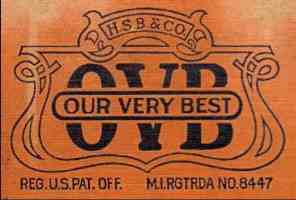
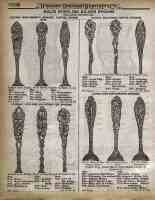
In this column we present an abstract from a page of the "SILVER HALLMARKS WORLDWIDE OVERVIEW"
courtesy of


HALLMARKS OF AUSTRIAN SILVER
MARKS AND HALLMARKS OF AUSTRIA AND AUSTRIA-HUNGARY
- 1781 - 1921 -
Ottoman expansion shifted the Hungarian kingdom under the rule of the Habsburg emperors and after the conclusion of the Great Turkish War the whole of Hungary became part of the Habsburg Monarchy. Following the nationalist uprisings of 1848, the Austro-Hungarian Compromise of 1867 elevated Hungary's status by the creation of a joint monarchy with the Austrian Empire, ruled in personal union as Austria-Hungary by the Austrian emperors during 1867-1918.
Until 1867 the fineness of Austrian silver was indicated in "loth"
(12 loth corresponding to 750/1000, 13 loth = 812/1000, 14 loth = 875/1000, 15 loth = 937/1000). An alphabetic symbol (in some cases accompanied by a number) identified the town control office.
From 1867 the silver fineness was indicated by a number beside "Diana head": 1=950/1000 - 2=900/1000 -
3=800/1000 -4=750/1000
In 1872 the alphanumeric code identifying the town was reinstated inside the "Diana" mark....
MORE
In this column
we present marks, information and history of silversmiths and
silver manufacturers.
This column is published under the kind permission of Giorgio
Busetto's website

THE MAUSER MANUFACTURING COMPANY
MERGING WITH HAYES & Mc FARLAND AND ROGER WILLIAMS SILVER COMPANY
FORMING MT. VERNON COMPANY SILVERSMITHS
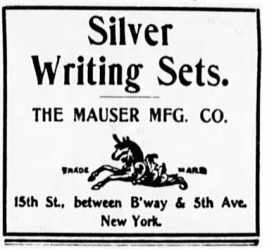
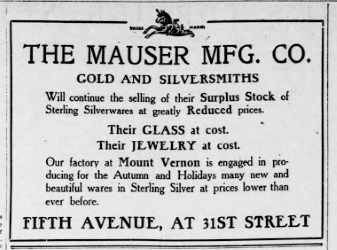
The business was founded in 1887 by Frank Mauser in North Attleboro, Massachusetts. In 1888 Frank O. Coombs became a partner in Frank Mauser & Co. beginning his activity in the firm as designer and chaser.
In the 1890s the firm moved to New York changing its name to Mauser Mfg. Co.
The factory was located in Mt. Vernon with shop in 15th Street and, from 1904, in the more expensive Fifth Avenue at the corner of 31st Street.
In 1903 Mauser Mfg. Co purchased J.B. & S.M. Knowles (founded in Providence, RI, in 1875).
Frank Mauser died in 1908 and the firm suffered a slow decline until the closure and the sale of the Fifth Avenue retail store in 1912.
In 1913 the Mauser Mfg. Co merged with Hayes & McFarland Company of Mount Vernon, NY, and the Roger Williams Silver Company of Providence, RI, forming Mt. Vernon Company Silversmiths.
Mt. Vernon Company Silversmiths was purchased by the Gorham Corporation in 1920 continuing production under its name until 1923.....
MORE...
In this column we
present images and descriptions of Crests and Mottoes of British,
Irish and Scottish families as engraved on silver items.
This column is published under the kind permission of Giorgio
Busetto's website

FAMILY CRESTS: LIST OF NAMES
ILLUSTRATED DIRECTORY OF FAMILY CRESTS
CONYNGHAM
The crest of William-Lenox Conyngham, esq. of Spring Hill, co. Londonderry.
The motto is "Over, fork over".
The crest is described as "a unicorn's head, couped, maned and horned".
The crest has been found on a sterling silver cup hallmarked Dublin 1812, maker Daniel Egan
This table is obtained from The Book of Entries of the Names, Places of abode and Marks of the several Silversmiths and Plate Workers residing in Sheffield, or within twenty miles thereof, who are required to send their goods to the Assay Office, lately established in the Town of Sheffield by an Act of Parliament lately passed in the Thirteenth Year of the Reign of King George the Third intituled:
An Act for appointing Wardens and Assaymasters for
Assaying Wrought Plate in the Towns of Sheffield
and Birmingham
YEAR 1799
Closing our March 2019 edition of ASCAS Newsletter I hope
you have appreciated its content.
Your comments, suggestions and advice will be of great help.
My thanks to Scott Davidson, Robin Gibson, Ole Lachmann, Marivic Limcaoco, Peter Markham, Dr. David N. Nikogosyan and Katherine Palthey for their precious contributions.
Giorgio Busetto
Secretary
DISCLAIMER AND PRIVACY POLICY
ASCAS is a community of people having a common
interest in antique silver.
It is a non-profit association without commercial links.
Membership is open to whomever has a true interest in
this subject matter.
ASCAS has no real property and no fees are requested nor
accepted from members.
ASCAS keeps in touch with its members only through
periodical newsletters, e-mails and web-site updating
and ignores and is not responsible for any other
activity pursued by its members.
Likewise, ASCAS is not responsible for opinions,
evaluation and images displayed, and in any form
published or supplied for publication, by its members
who, in any case, maintain the property of their works
and assure the respect of national and international
legislation about Intellectual Property.
ASCAS does not have the full addresses of its members (only
town, country and e-mail address are requested for
membership).
ASCAS handles and protects with care its members' e-mail
addresses, will not disclose the addresses to third
parties, will use this information only to reply to
requests received from members and for communications
strictly related to its activity.
These rules are expressly accepted by submitting the
membership request.
email:
silverassociation@yahoo.it
HOME
|
|















































